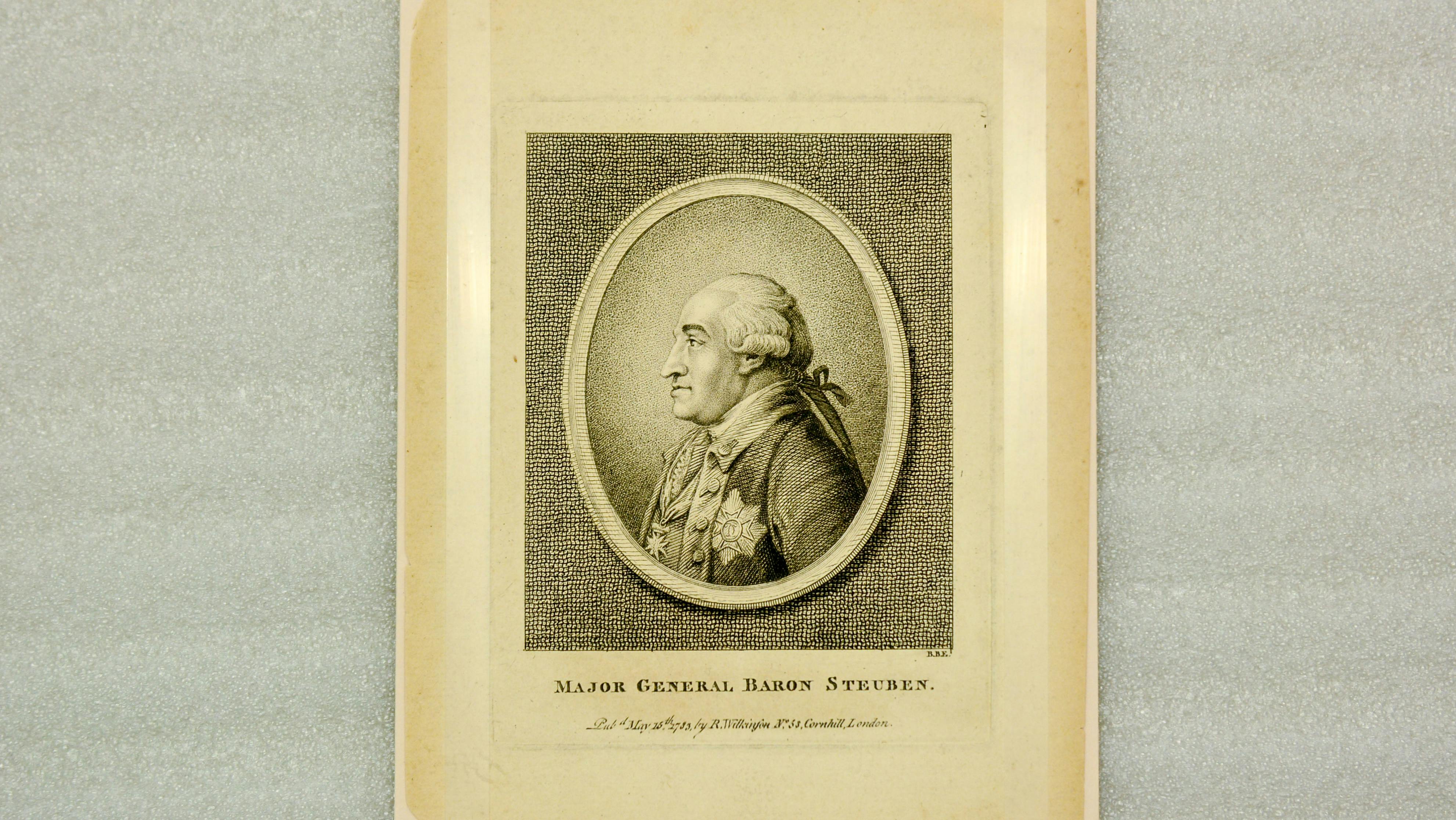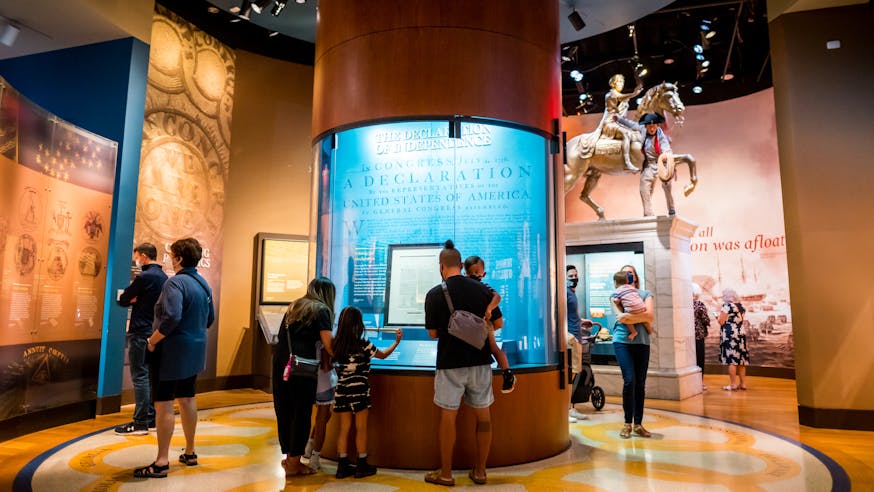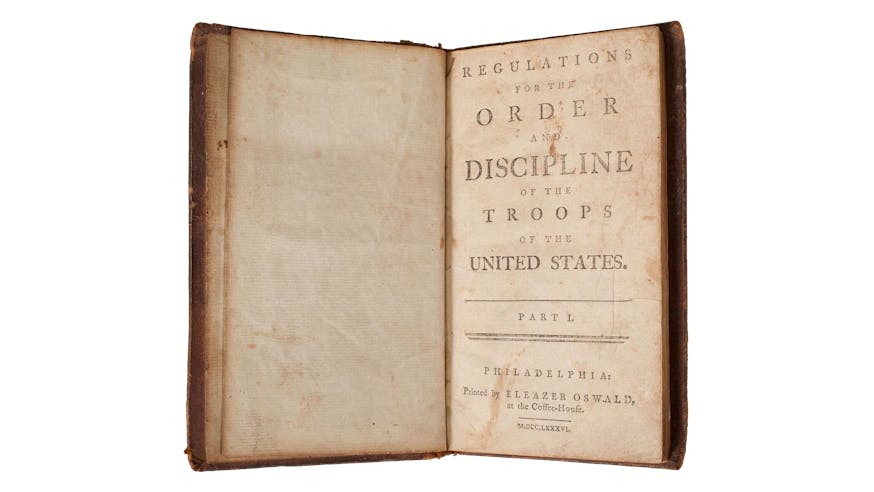News & Updates
Now on View: New Case Explores the Life of Baron von Steuben
May 31, 2024
He is a Gentleman of Family, Merit and great experience…Peter P. Burdett to Benjamin Franklin, June 10, 1777
Prussian immigrant and military leader Friedrich Wilhelm Ludolf Gerhard Augustin von Steuben (1730-1794), also known as Baron von Steuben, helped shape the Continental Army into a powerful fighting force during the Revolutionary War.
Steuben completed years of military service before sailing to America in 1777. During the Seven Years’ War (1756-1763), he served as an aide-de-camp (military assistant) to Frederick the Great (1712-1786), one of the most famous military commanders in Europe. Benjamin Franklin met Steuben in Paris in 1777 and recommended his military expertise to the Continental Congress.
At Valley Forge, Steuben led the training of the Continental Army under a new set of regulations, which made the army more professional and effective in battle. Following the end of the war, and longing to be seen as noble and wealthy, Steuben’s extravagant spending brought financial hardship. He spent the remaining years of his life seeking monetary support and a military pension. Steuben’s charming and charismatic behavior endeared him to his fellow soldiers and friends but his close and cherished relationships with men caused people to wonder about his sexuality.
See artifacts below — and on display at the Museum through December 2024 in the second-floor atrium case thanks to the Color Guard of the Pennsylvania Society of Sons of the Revolution — to gain a better understanding of who Baron von Steuben was.
Baron von Steuben's Military Service in America
Portrait of Baron von Steuben
on loan from Pennsylvania Academy of Fine Arts, deposited by Mrs. Martha L.M. Peters

Artist Charles Willson Peale (1741-1827) met Baron von Steuben at Valley Forge in 1778. Peale admired Steuben’s ability to make “a most important improvement in all ranks of the army.” In early 1780, General George Washington ordered Steuben to ask Congress for more money for the army. While in Philadelphia, Steuben commissioned this portrait from Peale. Steuben wears his Continental Army uniform with the cross and star of the Order of Fidelity, rewards he received from a German prince in 1769. The rewards signified an elevation to a higher social status that Steuben longed for.
English to German Dictionary
on loan from Brian and Barbara Hendelson

According to family tradition, Baron von Steuben owned this English to German dictionary. It may have helped him communicate during his time in America. Baron von Steuben spoke and wrote in both German and French but needed a translator to communicate in English. His personal secretary, Pierre-Étienne Duponceau (1760-1844), often helped Steuben translate his letters, orders, and regulations for his fellow Continental Army officers and soldiers.
Baron von Steuben’s Oath of Allegiance
Museum of the American Revolution

A few months after Baron von Steuben’s arrival at Valley Forge, General George Washington witnessed Steuben sign this oath of allegiance to the United States. Steuben chose to sign the oath as “de Stueben,” which was how French nobility signed their names. On Feb. 3, 1778, Congress declared that “all officers of the army shall take and subscribe the foregoing oath or affirmation before the commander in chief, or any general or brigadier general.” Steuben’s signing assured Washington and the Continental Congress that he was loyal to the Revolutionary cause.
Engraving of Baron von Steuben
on loan from Ernest "Chuck" Downs

Pierre Eugène Du Simitière (1737-1784), a Swiss artist living in Philadelphia during the Revolutionary War, drew a portrait of Baron von Steuben in 1779. It was later engraved, as shown here, and published in London with other portraits of American Revolutionary leaders. Baron von Steuben sat for the portrait around the time his military manual, Regulations for the Order and Discipline of the Troops of the United States, was first published.
Baron von Steuben's Military Regulations
Museum of the American Revolution

When he first saw the Continental Army at Valley Forge, the army’s condition shocked Baron von Steuben. Disheartened by the lack of shelter, food, equipment, and hygienic practices, Steuben began instituting a system of drill and discipline drawn from his Prussian military experience. One soldier recalled that he “was kept constantly…engaged in learning Baron Steuben’s new Prussian exercise.” Following the winter encampment, Steuben published Regulations for the Order and Discipline of the Troops of the United States, which the United States Army used through the War of 1812.
Letter Remembering Baron von Steuben
Museum of the American Revolution (Benninghoff Collection)

Encamped at Valley Forge, Captain Ezra Selden (1752-1784) of Connecticut wrote this letter to a friend and noted the rigorous training Baron von Steuben implemented. Selden mistook Steuben to be Polish:
Our Army is at present very busy and intent upon a New mode of Exercise Pointed by Major General Baron Steuben from Poland. His knowledge in Discipline is very great. His method of maneuvering is very Different; but mostly satisfactory, he never informs what is to be Done in future: but gives Lessons and we Practice
Selden and his troops implemented Steuben’s training at battles, such as Stony Point in 1779 where Selden was severely wounded.
Life After the Revolutionary War
Engraving of Baron von Steuben's Residence in Upstate New York
on loan from Ernest "Chuck" Downs

Following the end of the Revolutionary War, New York gifted a large piece of land in the Mohawk Valley to Baron von Steuben in recognition of his service to the United States. Steuben wintered in New York City and summered in his modest two-room log cabin (pictured here). His secretary, John Mulligan (1774-1862), lived with him and the two spend their time reading and playing chess. On Nov. 28, 1794, Steuben died in the cabin after suffering a stroke. Today, a replica of Steuben’s cabin stands near his gravesite and memorial near Rome, New York.
Letter: “My claim upon the United States”
Museum of the American Revolution

Steuben arrived in America with the understanding that the Continental Congress could not guarantee payment for his service. Steuben relied on generous friends to cover his travel, food, and equipment expenses during the war. Trying to maintain a façade of nobility and wealth, Steuben spent carelessly and always asked for more money. By the war’s end, he could barely cover his living expenses, let alone pay his staff. Steuben sent letters like this one to powerful politicians and businesspeople hoping they could help his fight for compensation and a pension. Two years after sending this letter, the United States Congress awarded Steuben a substantial annual pension of $2,500.
Estate Inventory
Museum of the American Revolution

Steuben’s estate inventory from December 1794 lists the items included in his residence following his death that November. Steuben wrote three versions of his last will and testament. The first two left his estate to a nephew in Europe, but after a falling out, Steuben symbolically adopted his Revolutionary Was aides-de-camp Benjmain Walker (1753-1818) and William North (1755-1862) as his children and left them most of his estate. John Mulligan (1774-1862), Steuben’s live-in secretary, inherited his library, maps, charts, and some money.
Was Baron von Steuben Gay?
Baron von Steuben’s sexuality has long puzzled historians and researchers. Steuben never married and his connection to likely gay members of the Prussian royal family, as well as his affectionate letters to his Revolutionary War aides-de-camp William North and Benjamin Walker, provide circumstantial evidence that he might have been gay.
Steuben’s bonds with Frederick the Great (who was likely gay), and Frederick’s almost certainly gay brother Prince Henry (1726-1802), meant that he lived and worked in an environment where some same-sex relationships were open secrets. In Europe and in the United States, attitudes towards same-sex relationships varied widely. Discretion remained a necessity, however, as even a whisper of same-sex attraction could destroy a person’s reputation.
Were the intimate and emotional letters Steuben wrote to William North and Benjamin Walker evidence of the writing styles of the 1700s or of a loving, romantic relationship? When Steuben lived with Walker, North, and John Mulligan, was it in recognition of their years of service to him, or was it symbolic of more intimate relationships? If Baron von Steuben was gay, he could not be open about his sexuality, so we may never know how he truly identified.
Maintaining His Appearance
Walking Stick and Shoe Buckles
on loan from Brian and Barbara Hendelson


Steuben lacked the funds to pursue the lifestyle he dreamed of, but he desperately wanted to maintain an appearance of wealth and nobility. The walking stick and shoe buckles displayed here, which Steuben allegedly gave to one of his relatives, helped him dress the part. As a Prussian military officer, Steuben preferred to carry a walking stick instead of a sword. He liked the air of authority and refinement it commanded.
Learn More

Plan Your Visit

Become a Member

